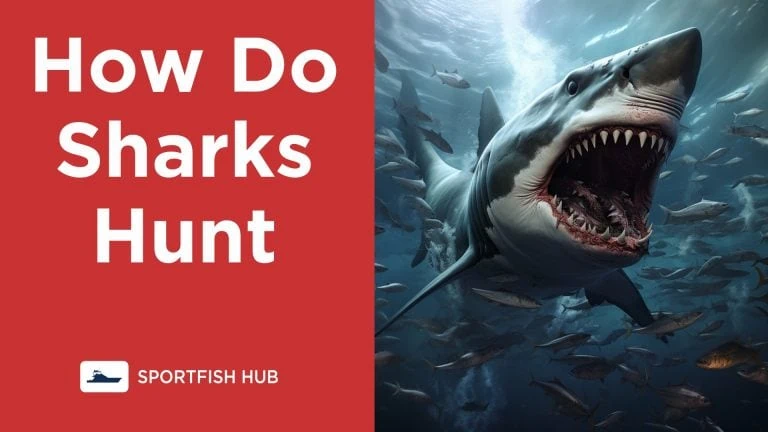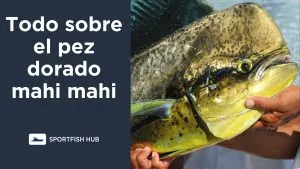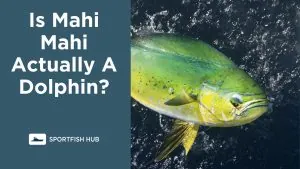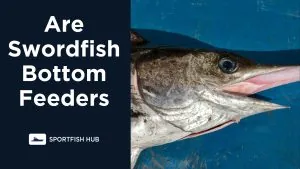Sharks are apex ocean predators that have perfected hunting over millions of years of evolution. Their diverse diets and specialized hunting strategies make them highly effective hunters able to thrive in every marine environment.
To understand what makes sharks such formidable hunters, I’ll examine how sharks hunt and the senses they use most to catch their prey.
You might also want to read: Why Do Sharks Eyes Roll Back?
Highly Developed Senses for Hunting
Sharks rely on their finely tuned senses to detect, identify, and hunt prey:
| Sense | Description |
|---|---|
| Smell | Can detect 1 drop of blood diluted in 1 million drops of water |
| Hearing | Detect noises from prey over 1 km away |
| Sight | Specialized eyes for low light vision |
| Touch | Lateral line system detects water movements and vibrations |
| Electroreception | Detect electrical fields from muscle contractions and heartbeats |
- Smell – A shark’s sense of smell is its most important hunting adaptation. Sharks have specialized olfactory organs that can detect tiny concentrations of molecules in the water. Some sharks like lemon sharks and blacktip reef sharks can detect 1 drop of prey extract diluted in up to 25 million drops of seawater.
- Hearing – Sharks can hear low frequency sounds and vibrations extremely well. They can detect noises from injured or struggling prey from over a kilometer away. Certain shark species like nurse sharks are attracted to the low frequency sounds made by potential prey.
- Sight – While shark vision is not the most acute in clear waters, many sharks have specialized eyes to see well in low light conditions. Many sharks have a reflective layer behind the retina that bounces light back through retinal cells, improving vision in dark or turbid waters where prey may hide.
- Touch – The lateral line system running along a shark’s body detects water movements and minute pressure changes. With their sensitive lateral lines, sharks can trail smells and feel vibrations, currents, and motion in the water to hone in on prey.
- Electroreception – Sharks can detect the weak electrical fields generated by prey’s muscle contractions and heartbeats using specialized receptors called the ampullae of Lorenzini. Even buried or concealed prey cannot hide from sharks due to these electroreceptors.
Diverse Diets and Prey
Sharks are opportunistic predators and eat various prey depending on their species. For more information on Shark Diets, visit our article: What Sharks Eat?
You might also be interested in reading about What Eats Sharks!
Specialized Hunting Strategies and Behaviors
The various shark species employ specialized hunting strategies and behaviors adapted to their anatomy, environment and prey:
| Shark Species | Hunting Strategy |
|---|---|
| Great white | Ambush attack |
| Mako | High speed pursuit |
| Tiger | Stalking and ambush |
| Bull shark | Bump and bite |
| Blacktip reef shark | Group hunting |
| Thresher shark | Use tail to stun prey |
| Nurse shark | Pin prey using fins |
| Hammerhead shark | Pin prey using head |
- Ambush Predators – Sharks like great whites, makos and tiger sharks often hunt by stealth and ambush. They hide in cover and wait motionless for prey to swim within striking distance before launching a rapid surprise attack. Their stealth allows them to conserve energy until prey is extremely close.
- High Speed Pursuit – Mako sharks are the fastest sharks in the ocean, capable of bursts of speed over 50 mph. Their speed allows them to pursue fast prey like tuna and even leap out of the water to catch prey. Makos rely on their speed for active hunting instead of ambush.
- Stalking – Sharks like tigers and sometimes great whites quietly stalk potential prey before attacking suddenly. Their dark gray tops provide camouflage when viewed from above so prey only see their light undersides. They take advantage of this counter-shading to stealthily approach within striking range.
- Bump and Bite – Bull sharks and other requiem sharks hunt with a technique called bump and bite. They bump prey repeatedly before attacking, possibly to assess the prey’s size and strength before committing to the hunt. This allows them to choose more optimal prey.
- Group Hunting – Some fast sharks like blacktips form hunting groups and work together to herd schooling fish into a tight bait ball to more easily capture prey. Sevengill sharks cooperate to hunt seals since lone sharks are not large enough to tackle these dangerous prey alone.
- Unique Behaviors – The thresher shark uses its long tail to stun and round up prey. Nurse sharks use their broad fins to pin prey to the sea floor. Hammerheads use their uniquely shaped head to pin down stingrays. Filter feeding sharks like whale sharks simply swim with open mouths gathering massive amounts of plankton.
Hunting Adaptations
In addition to their senses and strategies, sharks have advantageous anatomical and physiological adaptations that make them effective hunters:
- Streamlined, hydrodynamic bodies allow them to swim efficiently with minimal resistance. This facilitates high speed chases and rapid attacks.
- Their protrusible jaws can extend outward to reach prey. Rows of replaceable, razor-sharp teeth quickly shred prey.
- Their large gill slits allow them to swim constantly with their mouths open to filter huge volumes of water for plankton.
- Some sharks like makos and great whites have vascular counter-current heat exchangers that keep their muscles and eyes warmer than ambient temperatures. This allows them to hunt faster and see better even in cold waters.
- A shark’s liver is full of oil that provides buoyancy, allowing sharks to ascend and dive quickly to reach prey at different ocean depths.
FAQ
Are any sharks herbivores or plant-eaters?
No, all shark species are carnivores. Some special cases like bonnethead sharks can digest seagrass in addition to meat.
What senses do sharks rely on most when hunting?
A shark’s sense of smell and ability to detect faint electrical fields are their most vital hunting senses. Hearing, touch, and sight also help sharks find prey.
Do sharks hunt in freshwater?
Some shark species like bull sharks can tolerate freshwater and will enter rivers and lakes to find prey. Most sharks hunt in saltwater environments only.
How do basking sharks feed if they don’t have strong jaws and teeth?
Basking sharks are filter feeders that swim with wide open mouths to catch plankton in specialized gill rakers instead of teeth.
Summary
Sharks are highly successful apex ocean predators because of their evolutionary adaptations and hunting strategies tailored to their environments and prey. Their specialized senses, diverse diets, and variety of feeding behaviors demonstrate the results of millions of years of ocean survival and domination.












